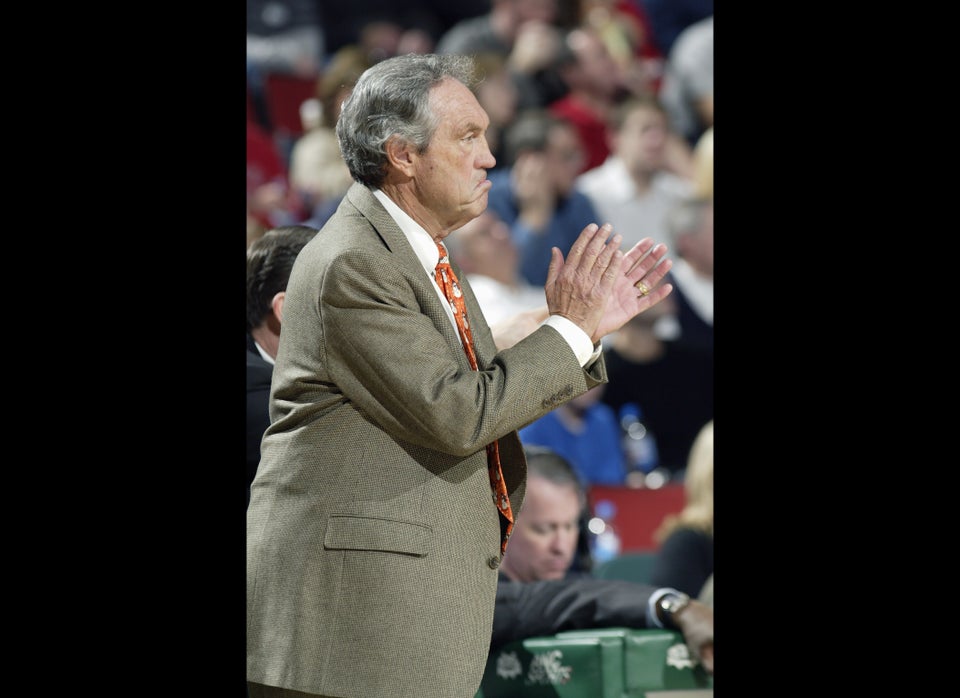By DAVE SKRETTA, The Associated Press
KANSAS CITY, Mo. -- Eddie Sutton remembers growing up on a farm in western Kansas, back in the days before college basketball was televised. He would lie in bed and listen to the radio calls from far-flung places like Oklahoma State and Kansas, and dream of stepping on the court for them one day.
Never in his wildest dreams could he imagine where the game would take him.
The first coach to take four schools to the NCAA tournament, Sutton joined coaching contemporary Bob Knight and three-time Naismith Award winner Ralph Sampson in leading an eight-member class into the National Collegiate Basketball Hall of Fame on Sunday night.
"It started with my parents. My parents made great sacrifices," Sutton said, recalling the meager sharecropping existence his family managed in the early 1940s. "They let me go practice when I should have been helping my dad do some farming."
Sutton eventually had the chance to play for Henry Iba at Oklahoma State, which was then called Oklahoma A&M, and would return years later to coach the Cowboys.
Along the way he built Creighton into a national power, led Kentucky to the NCAA tournament, and took Arkansas to the Final Four. He finished his career at San Francisco, where he logged his 800th win before retiring with a record of 804-328, having crossed paths with just about everyone who joined him in the sixth class honored by the Hall of Fame.
"I'm so proud to be here tonight with all these people, and to have dreamed, and now that reality has come true," Sutton said. "I'm humbled and extremely proud."
Along with Sutton, Knight and Sampson, the Hall of Fame honored former Michigan star Cazzie Russell, North Carolina standout James Worthy, St. John's star Chris Mullin, television pioneer Eddie Einhorn, and Joe Vancisin, the longtime executive director of the National Association of Basketball Coaches, who can recall playing in front of the game's inventor, James Naismith, way back in 1939.
The ceremony Sunday night tipped off a three-day college basketball celebration that includes the championship rounds of the CBE Classic. No. 24 Missouri plays Notre Dame and No. 23 California faces Georgia in the semifinals Monday night, with the consolation and title games Tuesday night.
But before some of the best teams in the country take the court, featuring some of the best players and coaches of this era, college basketball paused to remember its roots.
"I played before the 3-point line, and as Ralph and James and everyone here probably knows, in those short shorts. Very short and very tight," said Mullin, a schoolboy legend from New York City who became a star at St. John's and later one of the greatest shooters in NBA history.
Mullin was joined at the ceremony by his coach at St. John's, Lou Carnesecca.
"My four years in college I cherished very much, the opportunity to be able to stay at home," Mullin said, looking to his sides across a dais where the luminaries were seated. "It's truly an honor and I'll cherish for the rest of my life to be associated with people like this."
People like Russell, who starred at Michigan from 1964-66. The first player in school history to have his number retired, Russell built such a following that the university had to build Crisler Arena to accommodate all the fans who would crowd into Yost Fieldhouse to see him play.
Sampson is still considered one of the greatest players in college history, one of three to win three straight consensus player of the year awards. The 7-foot-4 Sampson helped Virginia to the Final Four in 1981, and was the first pick in the 1983 draft. He played nine seasons in the NBA before back problems and knee injuries forced him to retire.
Worthy led the Tar Heels of Dean Smith to two Final Fours and the 1982 championship, when he scored 28 points in a victory over Georgetown. He was selected first by the Los Angeles Lakers in the draft, and would become a seven-time All-Star and play on three NBA title teams.
"We're extremely honored, but I for one am honored because of the men that came before me, when I look at Cazzie and Joe and Coach Sutton," Worthy said. "Those are the types of people that laid the path for us youngsters to come and do what we've been able to do."
Knight was honored just a few days after watching his protege, Duke's Mike Krzyzewski, break his record for wins among men's Division I coaches. The longtime coach at Army, Indiana and Texas Tech has served as a presenter for other Hall of Fame inductees, but finally got his night under the spotlight.
So, too, did Einhorn, who founded the TVS Television Network. It was Einhorn who brought the ground-breaking game between Houston and UCLA in 1968 to a national audience, ushering in the era of college basketball on television. Now the vice chairman of the Chicago White Sox, Einhorn was joined at the induction by his old law school classmate, White Sox owner Jerry Reinsdorf.
"This is kind of unreal," Einhorn said. "When you go down and see the Hall of Fame plaques, I was looking at it today, I was saying, `I'm up there. I worked with a lot of those people.' "
People like Sutton and Sampson, Worthy and Knight, who laid the groundwork for March Madness, the billion-dollar TV contracts and the big business of college basketball today.
"The success that we've had, the people have made it possible for us – I appreciate being appreciated," Worthy said, "and it's an honor to be inducted with all of you."
